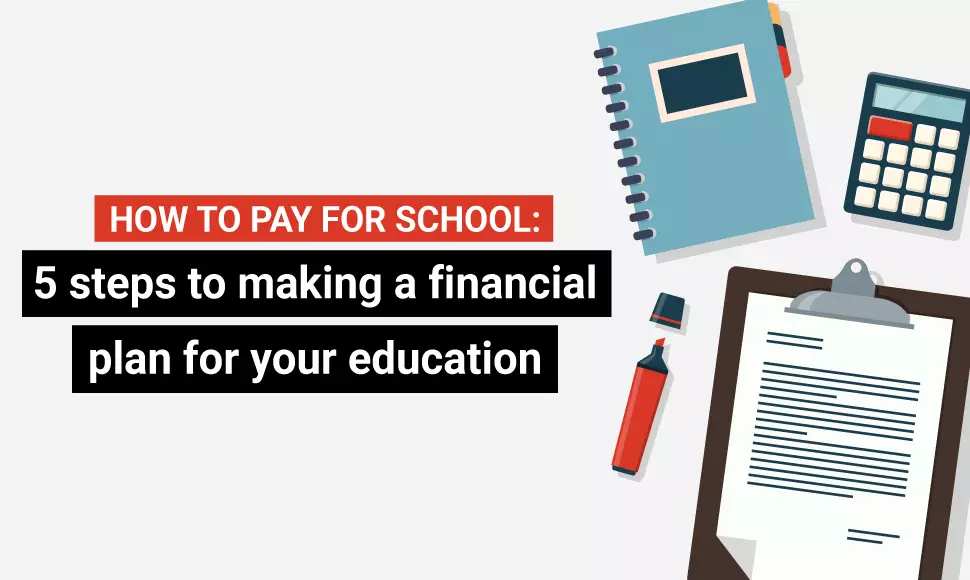How to make a financial plan for college
This article was updated on December 4, 2023.

Written by Michael Feder

Reviewed by Bronson Ledbetter, MBA, Vice President, Student Services and Financial Operations

5 ways to fit a financial plan for college into your budget
The idea of financing your education can seem daunting, but making a financial plan for college can include scholarships and grants to pursue, loans to consider and benefits to explore. No wonder the navigation process alone is enough to make some people press “delay” on starting the process at all.
The solution? A solid plan to finance your education. Here, you’ll find that plan broken down into five steps designed to get you on the right path.
Step 1: Research ways to save
Whether you’re looking for a short program or one that will last years, education can get expensive. That’s why it’s important to offset the costs as much as possible through scholarships, grants and, where possible, benefits, which do not have to be paid back.
Wondering what to do once you start your scholarship application? We break down the secret to a successful essay in our blog!
Scholarships
Scholarships can be available from both the school you’re looking to attend and outside sources. University of Phoenix , for example, offers a variety of scholarships for students looking to attend the University. You can find scholarship opportunities at phoenix.edu/scholarships
or phoenix.igrad.com/scholarships
, including up to $3,000 for every new, qualified student.
Scholarships, after all, come in a variety of forms, meaning you have options when it comes to eligibility. Doing a little research at the outset can go a long way to making a financial plan for your education that works around who you are as a person. Scholarship criteria can vary widely. Scholarships can be based on merit, sports, or even certain traits such as being a single parent. And, of course, it’s possible to earn more than one.
Researching and qualifying for scholarships is a must for anyone looking to avoid taking out student loans or dipping into their savings. Qualifying for scholarships and grants also makes for a great resumé booster as well!
If you’re interested in learning more about financing your education at University of Phoenix, read more about our scholarships.
Federal grants
Federal grants are funds that generally do not have to be repaid and are based on financial need. Federal Pell Grants and Federal Supplemental Opportunity Grants
typically awarded to undergraduate students who have exceptional financial need and have not earned a bachelor’s, graduate, or professional degree. In order to be considered for these grants, you must complete the FAFSA® application.
Military benefits
If you or a family member have served in the military, it’s possible you qualify for financial benefits you can apply toward your education. Such military benefits include:
- Active-duty tuition assistance with the cost of tuition
- The Post-9/11 GI Bill® , which generally offers up to 36 months of education benefits for veterans
- Work-study programs
In some cases, qualifying for these programs is fairly straightforward. For example, active duty, National Guard and Army Reserve servicemembers, as well as veterans who have served at least 90 days on active duty since September 11, 2001, you may qualify for the Post-9/11 GI Bill, which includes money for school tuition, living expenses and books.
Step 2: Start your plan
Once you’ve done the work of researching, applying for and (hopefully) earning one or more scholarship or grant, it’s time to start drafting your financial plan. This is when you’ll figure out whether or not you’ll need something to fill the gap between the price tag of your education and the money you have (whether it’s your own or a scholarship or grant).
Federal student loans
Many students looking to cover the cost of their education turn to the federal student loan program for help. In fact, according to 2015-16 data from the National Center for Education Statistics, many students take out federal loans. This program offers loans at competitive fixed interest rates and helps students reach their educational goals without taking out riskier loans. Direct Subsidized and Direct Unsubsidized Loans are generally available to all students, regardless of credit history. You don’t begin repayment on these loans until after you leave college or drop below half-time. In addition, federal student loans have flexible repayment plans and options to postpone payments if you have trouble making payments.
Private loans
Understand your rights and responsibilities when considering private loan options. Clear and accurate information can help you make informed choices, so you borrow only what you need and can reasonably repay.
The University encourages that all federal and state financial aid options are exhausted before private loans be considered. Private loans are made through third-party lenders and other financial institutions and are subject to a credit review and individual lender terms and conditions. Private loans are not subsidized or guaranteed by the federal government. For more information on the difference between federal and private loans, please visit the Consumer Financial Protection Bureau .
Private student loans may be available to both students and parents who are not eligible for federal financial aid or who need assistance beyond their financial aid eligibility. The lender determines eligibility, and amounts are limited to the cost of attendance minus other aid, including discounts and any other resources received.
Students may choose to use any eligible lender that offers private loans. The University does not maintain a list of lenders that offer private loans, nor will it endorse a particular lender.
Step 3: Plan your school-work-life balance
College can get expensive, which explains why about 81% of students take on at least part-time work and 43% balance their education with a full-time job.
Many students do not take the time to plan their school-work-life balance. The result can be a lot of stress, missed deadlines and even failing to attain your degree.
It’s important to be honest with yourself about what your needs are. Are you someone who has to operate on eight or more hours of sleep? Do you want time to see your friends on the weekend instead of cramming in the library?
These considerations do not compromise your commitment to your education. In fact, striking a healthy balance will bolster you mentally and physically to succeed in all areas of your life.
Work-school balance
If you’ve completed the previous steps but still need a little extra cash, then you may have to work while going to school. In this situation, it’s important to be transparent with your employer prior to taking on any position. That means having a frank discussion about the amount of time you’ll need for schoolwork and how you’ll manage your paid work with that schoolwork.
Having this conversation can lay the foundation for a healthy work-school balance. When your employer understands and is onboard with your situation, you can collaborate on a schedule that meets both your needs, especially if you need blocks of time for studying or attending class.
Of course, not all employers are willing to help. But the only way to find out what kind of employer you have is to have the conversation.
Some employers even offer tuition benefits to working students. Check with your company’s human resources department to see what might be available to you.
Step 4: Plan for the unexpected
A lot can happen while you pursue your education, especially over the course of a four-year program. The prospects for your chosen career path, for instance, are subject to market forces that are out of your control. Keeping yourself apprised of the latest news in your industry can help you make the necessary pivots for optimizing your education.
Understanding where and how you can be flexible goes a long way for this step of the financial plan. Talk to your academic advisor about policies relating to switching majors or taking on different courses. Getting this information ahead of time gives you the tools to be flexible, regardless of circumstances.
Research is a huge part of being prepared for the unexpected. Keeping up with what finances are available to you allows you to be more flexible when things don’t go exactly to plan. Chris Conway, director of financial education initiatives at University of Phoenix, highlights this point”
“If students really put the effort into finding that free money [of scholarships, grants and benefits], and things do change, then federal loans can be a good fallback. If you’re trying everything else first, then it’s good to have that safety net in case you need it.”
If you want to make some kind of adjustment, it’s important to give yourself the flexibility to change course. Saving up money in case of emergencies is a huge help in this regard.
Step 5: Watch out for new opportunities to add to your financial plan for college
When making your financial plan for college, remember grants, scholarships and loans are not only available during the application stage. Researching and applying for these opportunities can happen even after starting your degree. In fact, you should be checking these resources regularly, especially those that you’ve previously applied for. In many cases, it can take several applications to receive a competitive grant or scholarship.
In other words, don’t give up — even if you don’t get it the first time.
Making a financial plan for your education is a sound idea, not a scary one. The more you do ahead of time in terms of researching and applying, the more confident (and well-funded) you will be as you begin your degree program.
GI Bill® is a registered trademark of the U.S. Department of Veterans Affairs (VA). More information about education benefits offered by VA is available at the official U.S. government Web site at https://www.benefits.va.gov/gibill

ABOUT THE AUTHOR
A graduate of Johns Hopkins University and its Writing Seminars program and winner of the Stephen A. Dixon Literary Prize, Michael Feder brings an eye for detail and a passion for research to every article he writes. His academic and professional background includes experience in marketing, content development, script writing and SEO. Today, he works as a multimedia specialist at University of Phoenix where he covers a variety of topics ranging from healthcare to IT.

ABOUT THE REVIEWER
As Director of Financial Education Initiatives and Repayment Management, Chris Conway works with departments across the University to provide resources that allow students to make more informed financial decisions. She is also an adjunct faculty member for the Everyday Finance and Economics course at the University, and she chairs the National Council of Higher Education Resources College Access and Success Committee. Conway is committed to helping college students make the right financial decisions that prevent future collection activity.
This article has been vetted by University of Phoenix's editorial advisory committee.
Read more about our editorial process.
Read more articles like this:



